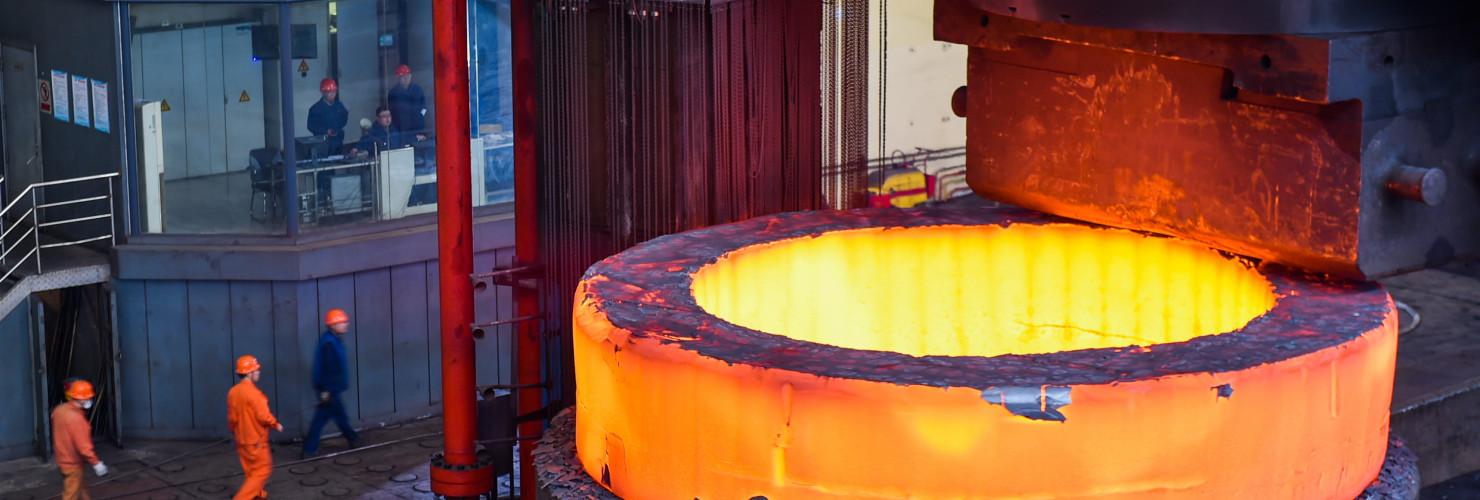

Forging and foundry industries + AI + Aligning university majors with strategic goals
MERICS Top 5
1. Going hammer and tongs: China to transform forging and foundry industries
At a glance: Three ministries led by the Ministry of Industry and Information Technology (MIIT) issued support for China’s foundry and forging industries. Policymakers regard the industries as “indispensable technological links” for equipment manufacturing and therefore as critical for the continued progress of China’s industrial development. Targets for 2025 include:
- Achieve breakthroughs in key areas of high-end casting and forging (e.g., 3D sand printing, ultra-high-strength steel thermoforming or integrated die-casting)
- Reduce particulate matter pollution in the foundry industry by more than 30 percent and reduce the energy consumption per ton of forged materials by 5 percent compared to 2020
- Encourage companies to integrate new digital technologies into manufacturing processes and improve product quality
- Attract foreign enterprises to set up R&D facilities in China and cooperate with Chinese firms
MERICS comment: China has been the world’s largest foundry and forging market for over two decades, but the sectors are fragmented, and high-end products are predominantly imported. The new policy seeks to guide companies up the value chain, upgrade downstream sectors like aviation, automotive and machinery and equipment, and improve industrial resilience.
European companies are global leaders in the high-value segments of the foundry and forging industries. On the one hand, foreign technology providers remain highly sought after partners for Chinese firms. The government will provide financial and policy incentives for European companies to localize production and R&D facilities in China. On the other hand, Beijing wants to reduce its reliance on foreign technology. Downstream firms, especially state-owned enterprises, will be encouraged to source locally. In addition, localization and R&D cooperation carry the risk of technology transfer. Firms in forging and foundry that have so far exported to China might need to assess whether their business model is sustainable.
As a recent MERICS and EUCCC survey shows, many foreign firms have to balance the risks and rewards of investment in an increasingly politicized business environment in China.
Article: Guiding Opinions on Promoting the High-Quality Development of the Foundry and Forging Industries (关于推动铸造和锻压行业高质量发展的指导意见) (Link)
Issuing bodies: MIIT, NDRC, MEE
Date: April 14, 2023
2. Cyber watchdog suggests far reaching regulation for generative AI
At a glance: The Cyberspace Administration of China (CAC) released a proposal for the regulation and standardization for systems similar to ChatGPT, collectively known as generative AI. The main goal is to establish state control over the development of AI products, as most of the 23 articles specify how the state regulator can hold AI providers accountable. According to the draft regulations, providers of AI generated content are required to:
- Seek approval by the CAC through a security assessment process
- Ensure that content generated by generative AI reflects the “core values of socialism with Chinese characteristics”, delete inappropriate content and update the algorithm within three months
- Take legal responsibility for content produced on their platforms and clearly label generated content such as videos
- Make sure that the training data of their algorithms does not violate intellectual property rights (IPR)
MERICS comment: Building on regulation of AI recommendation algorithms, this draft represents the first attempt worldwide to regulate the impact of generative AI. It places many legal responsibilities on the shoulders of providers and asserts the state’s authority over the development of this emerging digital field.
However, the draft demands extensive regulatory control and AI outputs to espouse Xi Jinping thought. These requirements raise compliance costs and slow China’s AI development. Perhaps by design, they veer companies away from fairly unrestricted chat bots such as ChatGPT towards more limited, specialized products.
Foreign companies can expect mixed results from these rules. On one hand, they can make full use of domestic generative AI solutions without worrying about being held responsible for the output, since that burden is placed on the providers. However, these regulations will likely accelerate digital decoupling between China and the rest of the world. Multinationals that integrate generative AI into work processes will need to find alternatives for operations in China. With OpenAI not available in China, companies cannot expect their China teams to use the same system that global teams use.
Article: Measures for the Management of Generative Artificial Intelligence Services (Draft for Comment) 国家互联网信息办公室关于《生成式人工智能服务管理办法(征求意见稿)》公开征求意见的通知 (Link)
Issuing body: Cyberspace Administration of China
Date: April 11, 2023
3. Universities to revise one fifth of majors to match strategic goals
At a glance: The Ministry of Education (MOE) is aligning the majors offered by tertiary institutions more closely with economic needs and Beijing’s strategic priorities. A new plan set targets for 2025 including:
- Optimize and adjust about 20 percent of the subject majors in colleges and universities
- Set up majors on new technologies, industries, and business models, and eliminate majors that are out of touch with economic and social development
- Establish about 10,000 national world-class majors and about 300 training bases for top students in basic disciplines (i.e., natural sciences)
- Build future technology colleges, modern industrial colleges, high-level public health colleges, and excellent engineering colleges
MERICS comment: The reform plan is a continuation of efforts to tailor China’s education system to strategic goals in science, technology and industry. For instance, 12 future technology colleges have already been established in top universities, aiming to develop cutting-edge or disruptive technologies over the next 10-15 years, in fields such as biomedical engineering, aerospace and semiconductors. The MOE has also compiled a list of urgently needed disciplines and majors, including quantum science and high-end equipment. Yet not all higher education institutes are following the government’s playbook. Some colleges and universities have recently added far more humanities and social science majors as they are cheaper to set up and operate, allowing for quick expansion. The government is seeking to halt this trend and boost STEM (science, technology, engineering and mathematics) related majors instead.
More broadly, China is facing a large and growing talent gap, primarily due to demographic trends. The MOE expects a shortage of 30 million manufacturing workers by 2025. Forcing universities to revise over 12,000 majors in the next three years will be prone to errors and unlikely to significantly reduce shortages of skilled labor by itself. To move forward with its ambitious plans for industrial upgrading, China will need to commit additional resources to the training of engineers and scientists. Comprehensive reforms to the education system, in areas like rural and vocational education, will also be key.
Article: Reform Plan for Adjusting and Optimizing the Setting of Majors and Specialties in Higher Education (教育部等五部门关于印发《普通高等教育学科专业设置调整优化改革方案》的通知) (Link)
Issuing bodies: MOE, NDRC, MIIT, MOF, MOHRSS
Date: April 4, 2023
4. Beijing ramps up rollout of controversial IPv6+ system
At a glance: Eight government agencies set targets for advanced internet infrastructure roll-out, focusing on the address system IPv6. Targets include an acceleration of the domestic roll-out and R&D as well as international standard setting. The main objectives set for 2025 are:
- Achieve breakthroughs in internet related innovation, such as IPv6 and supplementing alternatives, such as IPv6+, and become a leader in global IPv6 development
- Advance the ecosystem around IPv6, including the completion of core technologies (chips, security systems, software) and commercialization of specialized IPv6-related innovations, such as IPv6+, and Segment Routing (SRv6)
- Replace IPv4 in the internet backbone, 5G and other networks with IPv6-only (single stack), IPv6+ and other new solutions
- Promote the adoption of advanced internet technologies in industries like manufacturing, energy, finance and education, and create over 50 “IPv6+ innovation cities”
MERICS comment: The policy implements a three step plan from 2017 to upgrade China’s internet addressing system. The current protocol (IPv4) does not have enough unique addresses for all the devices connected to the world wide web today, necessitating a gradual transition to IPv6 across all global internet hardware. The new system will provide a stable foundation for the proliferation of digital devices connected to the internet.
A key difference of these new policy guidelines compared to previous plans is the unprecedented emphasis on IPv6+, a controversial alternative to the globally accepted IPv6. IPv6+ is a routing system for internet data that enables network providers to prioritize the transfers based on the type of content and who the senders or receivers are. Current standards do not allow such information to be shared and ensure net neutrality, i.e., the equal treatment of internet data transfers.
While net neutrality is being upheld in Europe, China is moving full steam ahead with the rollout of IPv6+ infrastructure and hopes to reap the rewards of additional network performance in virtually all sectors, ranging from smart manufacturing, to transport and energy. This could strengthen its position as a manufacturing base, to the detriment of other economies which ensure net neutrality in their jurisdictions, such as Europe.
Article: Implementation Opinions on Promoting the Evolution of IPv6 Technology and the Innovative Development of Applications (工业和信息化部等八部门关于推进IPv6技术演进和应用创新发展的实施意见) (Link)
Issuing body: MIIT, CAC, NDRC, MOE, MOT, PBOC, SASAC, NEA
Date: April 23, 2023
5. China’s innovative approach to incubate high-tech SMEs through strategic partnerships with large firms
At a glance: The MIIT released its first annual application call to match high-tech small and medium-sized enterprises (SMEs) with large enterprises, with the goal of creating R&D partnerships or supplier relationships. Part of a larger strategy to incubate and nurture high-tech SMEs, the call aims to:
- Strengthen coordination on industrial technological bottlenecks and innovation
- Improve the innovation capability of Chinese SMEs through collaboration and frequent interaction with large firms
- Provide preferential policies and financial support to SMEs that solve technical needs of large firms
Provincial departments are to ask large industrial enterprises about their technological needs. On this basis, the ministry will create a non-public catalogue for local SME authorities to send to officially recognized specialized SMEs. Large firms that agree to making their tech needs public will benefit from dissemination through a national online platform.
MERICS comment: Matching high-tech SMEs and large firms became an industrial policy focus in May 2022 (see MERICS China Industries Brief from June 8, 2022) and highlights Beijing’s mistrust of market mechanisms. According to policymakers, R&D efforts of SMEs should be directed towards strategic technologies – such as intermediary components – that large firms like Huawei or BYD need for their production.
The success of this program will depend on the enthusiasm among large firms, not all of whom will be eager to switch suppliers or advertise technological weaknesses. The bulk will likely watch how frontrunners fare, which are likely to include those with known supply chain weaknesses like Huawei, as well as SOEs. SMEs stand to benefit from increased demand and R&D support as well as government subsidies. For foreign firms this policy is another reminder of how China is seeking to oust them from potentially vulnerable supply chains. These matchmaking efforts relate to official lists of “Little Giants” (set for 10,000 by the end of 2023), and other plans to implement China’s “new whole state system” under which firms of different sizes are guided towards reducing China’s foreign technological dependencies and promoting innovation-driven development.
Article: Notice on Organizing and Carrying Out the 2023 Annual List of Large Enterprises and Unveiling of Small and Medium-sized Enterprises (关于组织开展2023年度大企业“发榜”中小企业“揭榜”工作的通知) (Link)
Issuing body: MIIT
Date: April 18, 2023
Noteworthy
Policy news
- March 28: The MIIT released draft guidelines on the national automotive chip standard system, aiming to develop over 30 key standards for automotive chips by 2025 (MIIT notice)
- March 28: The Ministry of Finance (MOF) announced that the super-deduction for R&D expenses (whereby 200 percent of eligible R&D expenses are deductible) will be extended beyond manufacturing enterprises to other sectors, beginning January 1, 2023 (MOF notice)
- March 29: The China National Intellectual Property Administration issued its annual work guidelines for 2023, emphasizing the role of high-quality development indicators and need to crack down on abnormal IP registration (CNIPA notice)
- March 31: The National Energy Administration (NEA) published guidance promoting the integration of digital technologies (smart meters, etc.) via pilot demonstrations in electrical grids and energy systems (NEA notice)
- April 10: The MIIT requested submission for model cases of Internet of Things applications in twelve subsectors such as manufacturing, agriculture, energy and health care (MIIT notice)
- April 14: The NEA outlined its priorities for 2023, including strengthening research into key technologies and equipment and establishing a database of projects seeking to deepen innovation in the energy sector (NEA notice)
- April 21: The State Administration for Market Regulation issued guidelines on the carbon neutral and carbon peaking standard system; the basic general standards focus on areas such as carbon emission accounting and verification, low-carbon management and assessment, and carbon information disclosure (SAMR notice)
- April 24: The MOF released amendments to the “Interim Measures for the Management of Subsidy Funds for Energy Conservation and Emission Reduction”; the changes extend the implementation period until 2025 and strengthen support for new energy vehicles (including fuel cell vehicles) and charging infrastructure (MOF notice)
Corporate news
- April 6: Swedish aluminum producer Gränges and China’s largest producer of aluminum alloy bars – Innovation New Material Technology – agreed to establish a JV to make aluminum alloy parts for EVs in China (Yicai Global article)
- April 6: Airbus signed new cooperation agreements with the Tianjin Free Trade Zone Investment Company and Aviation Industry Corporation of China to expand A320 family assembly capacity with a second production line in Tianjin (Airbus press release)
- April 8: China’s state-owned shipbuilder China State Shipbuilding Corp. has secured a record order to deliver 16 large container ships to French shipping giant CMA CGM worth CNY 21 billion (Caixin article)
- April 9: Tesla announced plans to open a factory in Shanghai that will produce Megapacks, a large scale lithium-ion battery unit for energy storage (Reuters article, Xinhua article)
- April 13: Volkswagen announced its software unit Cariad is setting up a joint venture with Chinese technology group ThunderSoft to develop China-specific features for the German automaker's “infotainment” systems and car cockpits (Reuters article)
- April 20: Huawei announces that it has replaced its Enterprise Resource Planning software, which it previously sourced from US vendors, with its own in-house system (Tech Wire Asia article)

